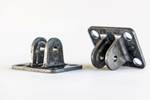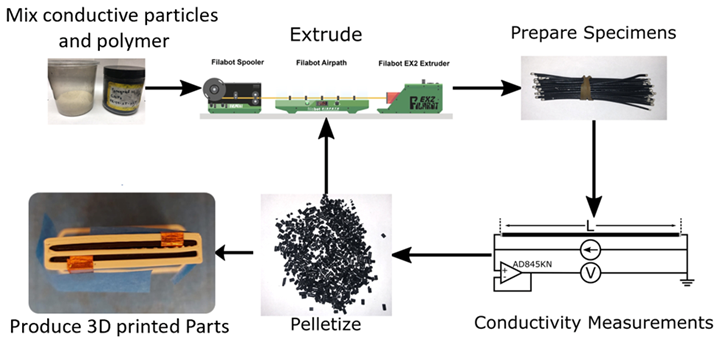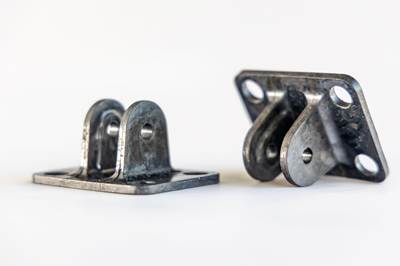Patent-pending Purdue process embeds sensor particles, functionalizes 3D-printed structures
Purdue University researchers have developed a novel wet-mixing method to add sensor particles to 3D printer filaments, which will enable manufacturers to create functional printed parts.
Patent-pending wet-mixing method for 3D-printed part functionalization. Photo Credit: Purdue University image/Brittany Newell
Purdue University (West Lafayette, Ind., U.S.) researchers have developed a patent-pending method to add particles to filament and disperse them evenly through a traditional fused deposition modeling (FDM) 3D printer, which will aid industry in manufacturing functional parts.
Brittany Newell and Jose M. Garcia-Bravo, associate professors in the School of Engineering Technology in the Purdue Polytechnic Institute, and Tyler Tallman, assistant professor in the School of Aeronautics and Astronautics in the College of Engineering, have created a novel wet-mixing method to introduce electrically conductive particles into 3D printing filament polymers. Cole Maynard, who earned his PhD in August, and Julio Hernandez, a doctoral candidate, were pivotal to the research.
According to researchers, traditional 3D printing makes prototypes of parts with no sensing capabilities. Sensors must be added to the part after the fact if assessments are to be made. The process can be thought of as adding sprinkles to cookies after they are baked: The sprinkles exist only on the outside of the cookie. Traditional foil-type strain gauges, which are the most common strain sensors, are adhered to the surface of a printed part by an epoxy resin, Newell explains. However, in this work the sprinkles are added throughout the cookie dough before baking. This means that sensing capabilities are an inherent part of the printed component and enable sensing inside of the component. Unlike sprinkles, these sensors are too small to be seen without a microscope. Their tiny scale is said to enable a printed part to maintain the strength it would have otherwise sacrificed due to large sensors built in, while still achieving fully integrated sensing capabilities.
“With this development, we can continually monitor the structural health of the part with the sensor embedded in the print.”
“Generally, we apply that strain gauge across the full part or apply it to the top and bottom of the part to get information on overall strain across the part,” Newell says. “However, the middle and internal structures are never monitored since the gauges are glued to the surface.”
The Purdue wet-mixing method ensures an even distribution of particles throughout the filament. With the sensors dispersed evenly in the filament, manufacturers and researchers can design parts with a wider variety of shapes.
“The results from this work enable users to create complex 3D structures with embedded strain gauges, rapidly moving traditional prototype pieces into fully functional and structurally assessable parts,” Newell adds. “A limitation of application of 3D-printed parts has been in their durability. With this development, we can continually monitor the structural health of the part with the sensor embedded in the print.”
This method produces materials that are conductive with high uniformity, which can greatly expand the electrical applications of 3D-printed parts and sensor designs. According to Garcia-Bravo “The materials are also tunable, meaning we can adjust the electrical and mechanical properties to optimize the sensor or part for a desired application.”
The novel wet-mixing process is not limited only to sensor conductivity, however. “This work can be further expanded to add other particle types using the same wet-mixing method,” Newell says. “This could include the addition of magnetic particles for electromagnetic fields, fluorescent particles and other functionalities.”
The research was published in the July 2022 edition of the peer-reviewed Advanced Engineering Materials journal, and in the 2020, 2021 and 2022 editions of the American Society of Mechanical Engineers Smart Materials, Adaptive Structures and Intelligent Systems journal. The researchers have received funding from the Naval Engineering Education Consortium (NEEC), a program from the NAVSEA warfare centers aiming to cultivate partnerships between the Navy and higher education institutions.
The researchers disclosed the innovation to the Purdue Research Foundation Office of Technology Commercialization, which has applied for a patent on the intellectual property. Industry partners seeking to further develop this innovation should contact Dhananjay Sewak, dsewak@prf.org, about reference number 69740.
Newell adds that industry partners are being sought to create a process to scale up and further test the method. “We need to increase the batch size to an industrial scale and integrate the customizable aspect of this work with industrial 3D printers,” Newell says. “The range of items that can be produced with these filaments is broad, and testing should be done to expand to new prototypes.”
Related Content
Materials & Processes: Fabrication methods
There are numerous methods for fabricating composite components. Selection of a method for a particular part, therefore, will depend on the materials, the part design and end-use or application. Here's a guide to selection.
Read MorePlant tour: Joby Aviation, Marina, Calif., U.S.
As the advanced air mobility market begins to take shape, market leader Joby Aviation works to industrialize composites manufacturing for its first-generation, composites-intensive, all-electric air taxi.
Read MorePrice, performance, protection: EV battery enclosures, Part 1
Composite technologies are growing in use as suppliers continue efforts to meet more demanding requirements for EV battery enclosures.
Read MoreA new era for ceramic matrix composites
CMC is expanding, with new fiber production in Europe, faster processes and higher temperature materials enabling applications for industry, hypersonics and New Space.
Read MoreRead Next
9T Labs, Purdue University to advance composites use in structural aerospace applications
Partnership defines new standard of accessibility to produce 3D-printed structural composite parts as easily as metal alternatives via Additive Fusion Technology, workflow tools.
Read MoreComposites end markets: Energy (2024)
Composites are used widely in oil/gas, wind and other renewable energy applications. Despite market challenges, growth potential and innovation for composites continue.
Read MoreFrom the CW Archives: The tale of the thermoplastic cryotank
In 2006, guest columnist Bob Hartunian related the story of his efforts two decades prior, while at McDonnell Douglas, to develop a thermoplastic composite crytank for hydrogen storage. He learned a lot of lessons.
Read More
























